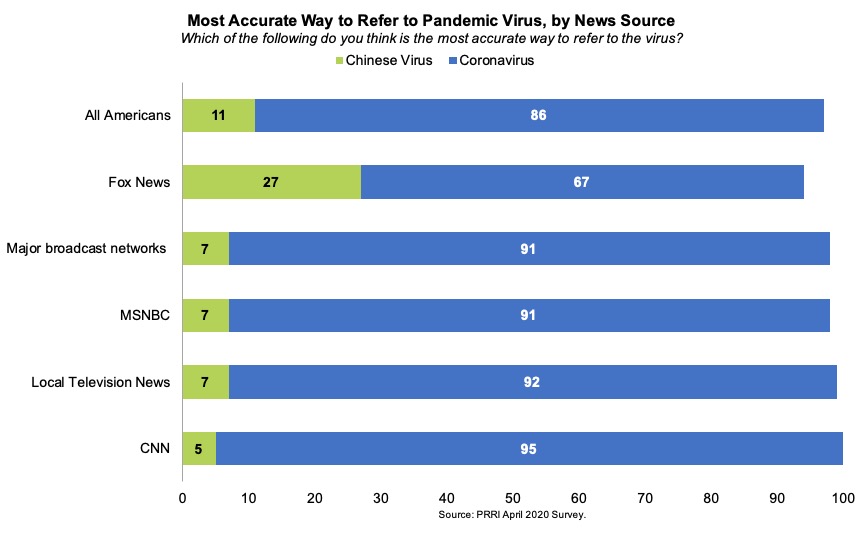Very Few Americans Attended Easter Services In Person
Despite the reports of a few clergy defiantly promising to hold in-person services on Easter weekend amid the growing coronavirus pandemic, the vast majority of Americans say their churches were closed on the most widely attended Sunday of the year, and very few indicated they planned to attend religious services in person. In a survey conducted April 6-11 just before Easter, only 8% of Americans who typically attend religious services at least a few times a year report that the place they primarily attend services was holding in-person gatherings for Easter or other religious occasions.[1]
Among typical religious service attendees, even fewer (3%) report that they planned to attend in-person services for Easter or other religious occasions. Among this group, more than six in ten (61%) say they planned to attend online services or watch television services for Easter or another religious occasion, compared to about one-third (32%) who did not plan to attend services in any form.

Who Participated in Online Services for Easter?
Participating in services online or on television does not significantly vary by religious affiliation. Among those who typically attend religious services, majorities of nonwhite Protestants (69%), white evangelical Protestants (65%), Catholics (63%), and white mainline Protestants (56%) say they planned to attend online services for Easter or other occasions.[2]
There is a particularly large gender gap, with more than two-thirds (68%) of women, compared to a slim majority (52%) of men, saying they planned to attend online services.
Notably, young Americans ages 18-29 (47%) are less likely than older groups ages 50-64 (66%), and seniors ages 65 and over (68%) to say they planned to attend online services, while those ages 30-49 (59%) fall in between.[3]

Typical attendees of all races report similar attendance patterns. About six in ten white (60%) and nonwhite (61%) report that they planned to participate in online or television religious services.
Geography also does not seem to affect the likelihood of attending online services among Americans who attend religious services at least a few times per year. Residents of the South (64%) are not notably more likely than residents of the Northeast (61%), West (60%), or Midwest (57%) to say they planned to participate in online services. Urban (60%), suburban (62%), and rural (61%) residents are also equally likely to say they planned to online religious services.
Religious Americans Avoiding In-Person Services Regardless of “Stay-at-Home” Orders and Religious Exemptions to Those Orders
As of mid-April, nearly every state in the U.S. has issued some form of a “stay-at-home” order to slow the spread of the coronavirus. How these orders apply to religious gatherings varies from state to state. However, this patchwork of restrictions does not significantly change reports of attending services. Typical service attendees in states with no restrictions on religious gatherings are no more likely than those in states banning all gatherings to report planning to attend religious services in person (5% vs. 3%, respectively). [4]
Nor do the restrictions have a large effect on reports of religious centers holding services. Among typical religious service attendees, less than one in ten of both those who live in states with no restrictions and those who live in states banning all gatherings without exemptions say the place they attend services is holding in-person gatherings (8% and 9% respectively). [5]

Support for Religious Exemptions to Stay-at-Home Orders
Only about one in five (21%) Americans favor allowing churches and religious organizations to hold in-person services even when the government has issued a stay-at-home order. More than three in four (77%) oppose such a religious exemption, including 40% who strongly oppose such a policy.
Americans who live in states with no restrictions on religious gatherings (22%) are more likely than those who live in states banning all gatherings with no exemptions (14%) to say they favor allowing in-person religious gatherings.

The Impact of Religious Affiliation, Party Affiliation, and Education
White evangelical Protestants (33%) are more likely than other religious Americans to favor allowing in-person religious gatherings. Fewer than one-quarter of nonwhite Protestants (25%), religiously unaffiliated Americans (18%), white Catholics (18%), and white mainline Protestants (15%) favor allowing in-person religious gatherings.
There is a slight partisan gap, with just over one in four Republicans (28%) saying they favor allowing in-person religious gatherings, compared to around one in five Democrats (20%) and independents (18%). More than two-thirds of Republicans (68%) compared to around eight in ten Democrats (81%) and independents (78%) oppose allowing religious groups to host in-person gatherings.

The education gap persists among all Americans. More than one in five Americans with a high school degree or less (24%), or with some college (22%), compared to 16% of Americans with a four-year degree and 14% of Americans with a postgraduate degree, favor allowing in-person gatherings.
The education gap persists among all Americans. More than one in five Americans with a high school degree or less (24%), or with some college (22%), compared to 16% of Americans with a four-year degree and 14% of Americans with a postgraduate degree, favor allowing in-person gatherings.
The Fox News Effect
Americans who trust Fox News most to provide accurate information about politics and current events are around twice as likely as Americans who most trust any other news sources to say they favor allowing in-person religious gatherings (33% vs. 17%). [6]
There is a notable Fox News effect among Republicans, white Christians, and whites without a college degree. Nearly four in ten (39%) Republicans who trust Fox News most favor allowing in-person gatherings, compared to 19% of Republicans who trust another news source most. Among all white Christians, 35% of those who trust Fox News most favor allowing in-person gatherings, compared to 18% who most trust any other news source. Similarly, among whites without a college degree, 38% of those who trust Fox News most favor allowing in-person gatherings, compared to 18% who most trust any other news source.
Coronavirus vs. “Chinese Virus”
In the first weeks of the coronavirus pandemic spreading across the United States, President Donald Trump continually referred to the virus as the “Chinese virus,” arguing that the term accurately describes where the virus originated and ignoring critics who said the term amplifies xenophobia. He has since backed away from using the term, but not all Americans have. The vast majority of Americans (86%) say that the most accurate way to refer to the virus is “Coronavirus,” but 11% of Americans say “Chinese virus” is more accurate.
Across religious groups, Catholics (20%) stand out as those with the highest percentage to say that the most accurate way to refer to the virus is Chinese virus, compared to only 11% of white evangelical Protestants, 11% of nonwhite Protestants, 8% of white mainline Protestants and 6% of religiously unaffiliated Americans.
Republicans (20%) are twice as likely as independents (10%) and about three more times as likely as Democrats (6%) to say that the most accurate way to refer to the virus is Chinese virus. News source matters more than partisanship.
More than one in four (27%) Americans who most trust Fox News say that the most accurate way to refer to the virus is Chinese virus, compared to only 5% of those who trust CNN most and 7% each of those who trust major broadcast networks, MSNBC, or local television news. The percentage who say Chinese virus is more accurate increases slightly to 30% among Republicans who most trust Fox News. Among all white Christians, 27% of those who most trust Fox News say that the most accurate way to refer to the virus is Chinese virus, compared to 6% who most trust any other news source. Similarly, among whites without a college degree, 25% of those who most trust Fox News say that the most accurate way to refer to the virus is Chinese virus, compared to 8% who trust any other news source.

There are a number of differences across lines of education, race, age, and gender. Americans with a postgraduate education (6%) are notably less likely than those with a college degree (12%), some college (11%), and a high school education or less (13%) to say that the most accurate way to refer to the virus is Chinese virus.White and Hispanic Americans (11% vs. 13%) are more likely than black Americans (5%) to refer to the virus as Chinese virus.[7]
Senior Americans ages 65 and over (16%) are about twice as likely as young Americans ages 18-29 (8%) and Americans ages 30-49 (9%) to say that the most accurate way to refer to the virus is Chinese virus. Middle-aged Americans ages 50-64 (13%) fall in between.
Men are about twice as likely as women to say that the most accurate way to refer to the virus is Chinese virus (15% vs. 8%).
Survey Methodology
The survey was designed and conducted by PRRI. Results of the survey are based on bilingual (Spanish and English) RDD telephone interviews conducted between April 6 and April 11, 2020, by professional interviewers under the direction of SSRS. Interviews were conducted among a random sample of 1,007 adults 18 years of age or older living in the United States (703 respondents were interviewed on a cell phone). The margin of error for the survey is +/- 3.4 percentage points at the 95% level of confidence, which includes the design effect for the survey of 1.2.
Citations
[1]These questions about religious services exclude Americans who reported seldom or never attending services, or did not answer the question. The sample size for those who attend at least a few times a year is n=588.
[2]Nonwhite Protestants who say they attend at least a few services each year have a sample size of n=90. Results should be interpreted with caution
[3]Young Americans ages 18-29 who say they attend at least a few services each year have a sample size of n=87. Results should be interpreted with caution.
[4]States with restrictions include those which do not allow religious exemptions or only allow limited restrictions to stay-at-home orders; states with no restrictions include those with full religious exemptions and those with no stay-at-home orders. States with unclear orders or variance by city or county are the third group. States were classified based on their status on April 12, 2020. The website is updating to reflect real-time changes. https://religionnews.com/2020/04/09/see-which-states-have-religious-exemptions-in-their-stay-at-home-orders/
[5]The sample size among those attending a few times a year or more for residents of states banning all gatherings without exemptions for religious gatherings is n=78. Results should be interpreted with caution.
[6]Americans are divided over whether they most trust local TV news (22%), Fox News (21%), CNN (20%), the major broadcast networks (20%), while fewer trust MSNBC (9%).
[7]Sample size for black Americans is n= 88.
